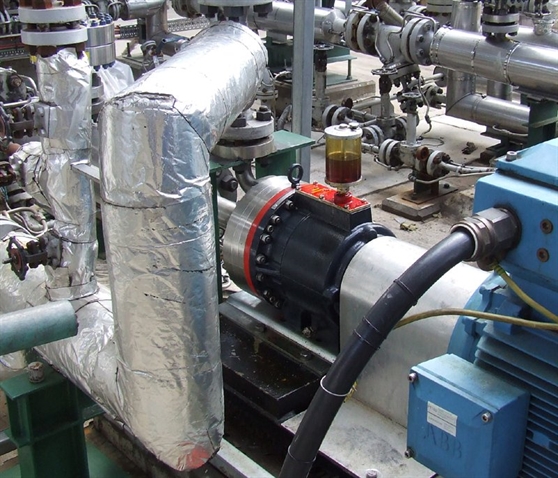Hot Liquids
Hydra-Cell® pumps reliably handle hot liquids up to 250°F / 120°C*.
Pumping hot fluids can be a difficult application. Concerns include avoiding cavitation and maintaining proper lubricity in the hot water pump's hydraulic end. Chemical attack on dynamic seals and packing is accelerated as the liquid temperature increases. Increasing maintenance. Pumps with dynamic seals need special and expensive seal and packing materials; seal flushing may also be required.
Many liquids are thinner when hot, and as temperature rises their ability to lubricate the seals reduces, rendering them less effective and increasing risk of internal leakage. Some liquids can become more corrosive at higher temperatures. For example, water becomes more corrosive at 194°F / 90°C than at 68°F / 20°C.
The seal-less design of Wanner Hydra-Cell Pro® pumps enables them to handle virtually any liquid over a wide range of temperatures and pressures. When handling hot liquids, a key feature of the Hydra-Cell Pro design is that the pumped liquid is isolated from the drive mechanism and 100% contained within the fluid end. The pump can handle heat simultaneously with other demands of the system, such as high operating pressure, harsh liquid content and poor lubricity.
In the Hydra-Cell Pro design, with no seals to wear, heat is not a factor, so the pump continues to be reliable, even up to 250°F / 120°C, with the viscosity of the lubricant in the drive end of the pump held within prescribed limits.
*NOTE - For some installations, an oil cooler maybe needed for some duties over 90°C/ 194°F. Consult factory for correct component selection for temperatures from 160°F (71°C) to 250°F (121° C).
Wanner Application Briefs

Continuous Recirculation of Boiler Water
A large refining facility requires continuous recirculation of hot boiler water at 200-210°F (93-99°C). The hot water pump application requirements included: direct coupling, explosion proof motor, and only a reservoir tank to offer for supply of near-boiling water.
Normally a pressure-feed suction would be necessary to avoid cavitation. By increasing the supply line plumbing to 2 in. (51mm), positioning the hot water pump close to the tank, and changing some plumbing at the top of the tank to create a full 10 feet (3.1 m) of static head, the hot water pump was able to run at full RPM without cavitation.
Vacuum Tank Cleaning Trucks Utilize Hot Water Pumps
An OEM, who manufactures Vacuum Tank Cleaning Trucks are used in the sewage industry for a variety of related applications including cleaning of portable toilets. A specific requirement was the ability to run the hot water pumps dry. Hydra-Cell Pro hot water pumps have no cups, packings or seals, and therefore, can run dry.
We can help
Wanner’s technical engineers can assist you in selecting a Hydra-Cell Pro seal-less pump to reliably handle your most challenging process liquids.
- Low NPSH due to High vapour pressure?
- Need assistance or support with NPSH in terms of system design?
- Are you replacing other pump technologies for abrasive/slurry duty application?
- Our technical engineers can assist with selecting a Hydra-Cell seal-less pump to reliably handle your process liquid.
Hydra-Cell Pro® Seal-less Pumps Reliably Handle Hot Liquids
- Acetic Acid
- Acidic Gel
- Amine
- Animal Fats
- Benzene
- Benzol
- Biodiesel
- Calcium Chloride
- Cleaning Agents
- Cocoa Mass
- De-ionised Water
- De-mineralised Water
- Detergents
- Dextrose
- Ethyl Acetate
- Ethylene Glycol
- Fumaric Acid
- Gasoline
- Gasoline (Straight Run)
- Grape Seed Oil
- Hot Water
- Hydrocarbon Condensate
- Latex Acid
- Lubricating Oil
- Malic Acid
- Methanol
- Mono Ethylene Glycol (MEG)
- Naphtha
- Nitric Acid
- Nougat Mixes
- Oil
- pH Stabiliser
- Phosphoric Acid
- Potassium Hydroxide
- Recycled Water
- Salt Water
- Sodium Hydroxide
- Sour Water
- Steam Condensate
- Sugar Syrups
- Sulphuric Acid
- Toluene
- Tri-Ethylene Glycol (TEG)
- Water
- Xylene
